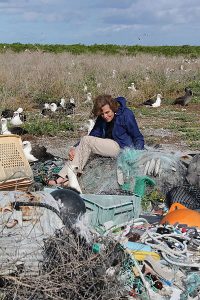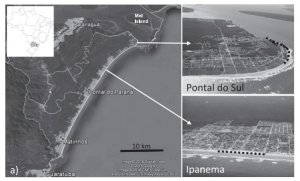Does marine debris affect tourist perception and tourism revenue?
By Casey Dresbach, SRC Intern
The top worldwide providers of ecosystem services of both leisure and recreation include coastal areas such as beaches and estuaries (Millennium Ecosystem Assessment, 2005). These natural environments are home to hundreds of thousands of marine organisms, all of which require clean domains to flourish, thrive, and grow in. Unfortunately, human pollution has made its way into these areas, as depicted in Figure 1. “Marine debris” can be defined as any solid, persistent, human-created waste that has been deliberately or accidentally introduced into a waterway or ocean from shorelines to the ocean floor (Oregon Coast STEM Hub, 2017). Not only does this breed of debris directly affect marine species ocean-wide, but current research is also showing that it is taking a toll on both tourism and tourists’ destination choices worldwide.

Dr. Sylvia Earle engaging with a Laysan albatross nesting among marine debris. (USFWS – Pacific Region, 2012)
Marine debris is complex in its nature and jeopardizes other coastal entities. The debris has a dual effect on both the marine life as well income generated from local tourism. The interaction between marine debris and tourism is complex because items may form in regions other than the places where the litter is stranded and where tourism occurs (Krelling, Williams, & Turra, 2017). Individuals visiting beaches and coastal regions are more likely so seek alternate destinations if their overall experience is not remarkably enjoyable, and a substantial amount of scattered litter may play into that alternative choice of destination.
The coast of Paraná state in southern Brazil is one of the most frequented tourist destinations in this region (Krelling, Williams, & Turra, 2017). Many tourists, such as second-home owners and users (SHOU) and non-recurrent vacationers, frequent this Brazilian coast. A single SHOU is an individual or group of individuals who have an additional property, or vacation home elsewhere. And a non-recurrent tourist is an individual who has no territorial tie to a destination – is interested in vacation without having loyalty of a piece of land. In a recent study by researchers Allan Krelling, Allan Williams and Alexandra Turra, both the perceptions and reactions of these two distinct groups of beach users were compared. More than 70% of the visitors are SHOU. In fact, some of Paraná’s cities are dependent on property taxes from these second homeowners as well as the expenditures spent by the non-recurrent tourists on services such as food, activities, and other conveniences. Collectively, the two user groups and their tourism revenue drive the economy in the coastal area.

(a) Depicts the entire coastal region of Paraná State in southern Brazil. (Top right) Pontal Do Sul, a highly frequented estuarine beach in the coastal region of southern Brazil. (Bottom right) lpanema, a highly frequented open ocean beach in the coastal region of southern Brazil (Krelling, Williams, & Turra, 2017).)
The study compared both the perceptions and reactions of the two user groups. SHOU and non-recurrent tourists were administered a questionnaire to determine socioeconomic characteristics at two Brazilian sub-tropical beaches: Pontal do Sul and Ipanema, exhibited in Figure 2. Pontal do Sul is an estuarine beach and Ipanema is an open-ocean beach, which is more frequented by non-recurrent tourists. The ultimate goal of the questionnaire was to characterize these beach users’ socioeconomic characteristics such as yearly income, level of education, daily per person expenditure, frequency of trips and period of permanence (Krelling, Williams, & Turra, 2017). The survey also examined perceptions and reactions, especially those regarding the potential negative economic impacts of marine debris. Pontal do Sul and Ipanema were selectively chosen because of their varying geographical characteristics, ultimately adding more variability to the study set.
The general findings showed that SHOU might have a different reaction towards the marine debris than the average tourist. This can be linked to their loyalty to the destination, specifically tied to the property they have there. Results did show, however, that if debris were to reach a significant amount (>15 items/m2), more than 85% of beachgoers would look elsewhere when searching for a coastal region to vacation (Krelling, Williams, & Turra, 2017). If this were the case the stranded litter would threaten the Brazilian economy by reducing local tourism income by 39.1%, (Krelling, Williams, & Turra, 2017) which would present losses up to $8.5 million a year.
In order to improve beach users’ experience, moving forward, an issue like marine debris should be prioritized. Marine debris can be a stressor that impacts coastal tourism worldwide. An evaluation of economic impacts caused by litter presence is a unique approach to analyzing how to minimize the threat litter may pose to tourism revenue. Some factors that may influence a visitor’s beach choice may include beach length, scenery, water quality, amenities (restaurants, shops, etc.), and quantity of litter. The additive effect of these factors determines the overall impression the trip will leave on the visitor. Stranded beach litter is considered to be one of the five most important aspects regarding beach quality in Europe, USA, Mexico, and the Caribbean (Krelling, Williams, & Turra, 2017). More research should be done in order for authorities to decide how to best go about balancing investments to remove marine litter and minimize the potential reduction of tourism revenue. Through integrated planning, the sources of litter can be determined and preventive strategies can be put into play. This would help to avoid a reduction in environmental quality and income generated from tourism.
Works Cited
Krelling, A. P., Williams, A. T., & Turra, A. (2017, August 15). Differences in perception and reaction of tourist groups to beach marine debris that can influence a loss of tourism revenue in coastal areas. (H. Smith, Ed.) Marine Policy.
Millennium Ecosystem Assessment. (2005). Ecosystems and Human Well-being: Synthesis. Washington, DC: Island Press.
Oregon Coast STEM Hub. (2017). Marine Debris – Composition and Abundance. (L. C. Schools, O. C. Newport, N. M. Program, & S. G. (Oregon), Producers) Retrieved from Conserve Wildlife New Jersey:
http://oregoncoaststem.oregonstate.edu/marine-debris-steamss/md-grades-4-5/composition-and-abundance
USFWS – Pacific Region. (2012, January 11). Dr. Sylvia Earle talks to an albatross nesting among marine debris. (A. Collins, Producer) Retrieved from Wikimedia Commons: https://commons.wikimedia.org/wiki/ File:Dr._Sylvia_Earle_talks_to_an_albatross_nesting_among_marine_debris.jpg




Leave a Reply
Want to join the discussion?Feel free to contribute!